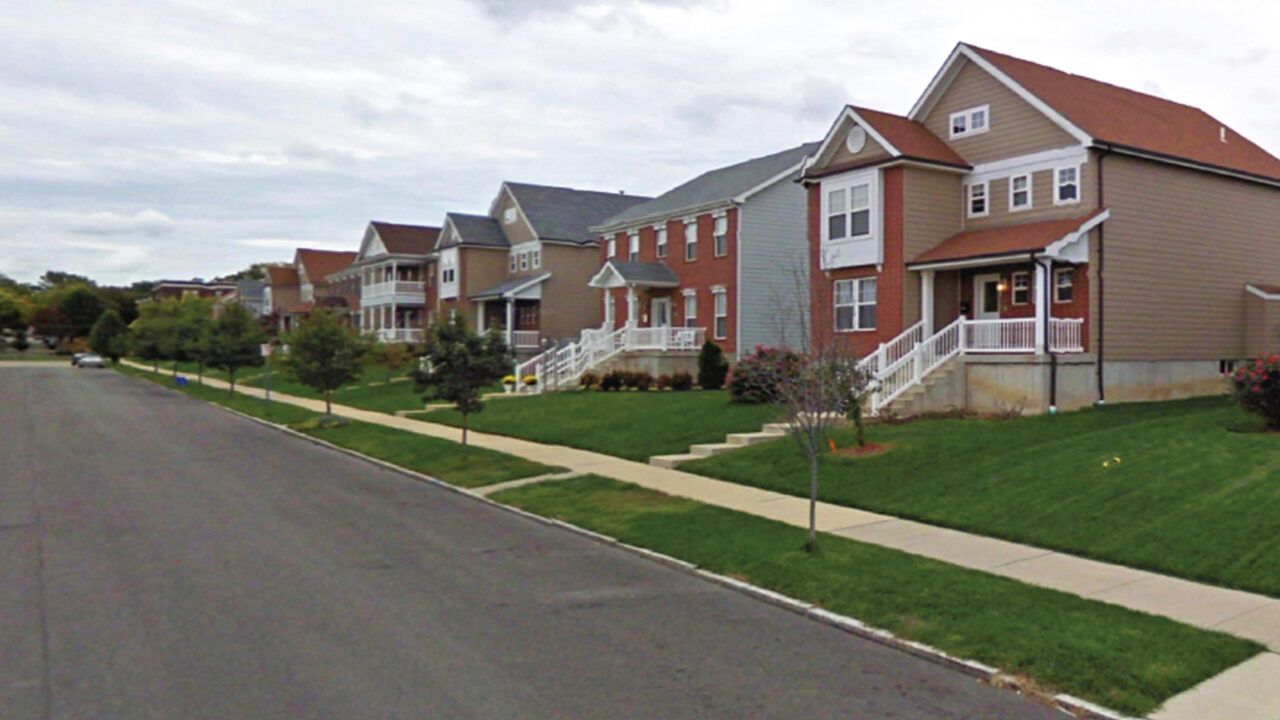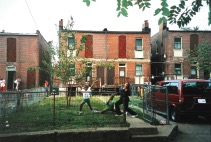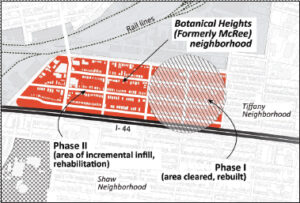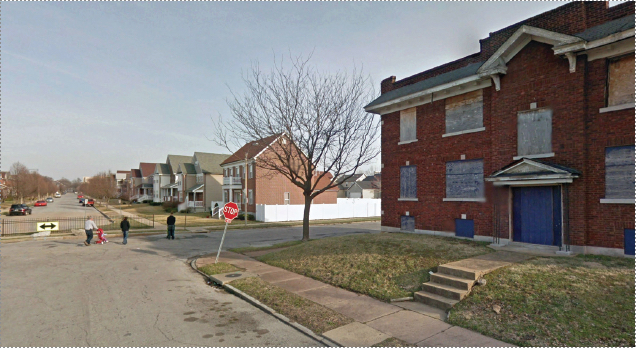
“Don’t miss the opportunity to become the owner of a great home in a great neighborhood!”
—2020 Zillow description of a house for sale in Botanical Heights, St. Louis, Missouri. The house was built on land taken by eminent domain from its prior owners in 2004. After they were forced to leave, their houses were torn down.¹
If you drive down the 3900 block of McRee Avenue in the Botanical Heights neighborhood of St. Louis, Missouri, you will see rows of relatively new houses with neatly-cut lawns and personal touches on doors and porches. There are small trees along the sidewalks, a testament to the newness of the houses, which were built from 2005 to 2007. At first glance, the neighborhood seems a model of stability in a place that was not long ago the city’s worst space of crime and poverty.
Despite being in the heart of the city, the houses are familiarly suburban. There is a slight nod to the history and urbanity of their location, as some home models include a “city” series and “heritage” series of historic-inspired plans and aesthetics. (The idea of “heritage” also helps owners conjure a sense of tradition and imagine deeper feelings of connection to this newly-rebuilt space.) The houses sit on wide parcels with generous spacing between them. Some have open floorplans and archways between rooms—these are technically fake arches, since they do not actually transfer loads as the structure implies. They also have attached garages, eat-in kitchens, and pitched, gabled roofs with dormers. If those elements were not telltale enough of middle-class markets and the suburban commercial home building industry that made them, the concrete foundations, vinyl siding and brick veneer fronts are also there. Despite the area’s innate “urbanity”—so close to downtown and so tied to the city’s history of a working-class—these features inscribe a suburban bubble of separation from that context.
Beneath the veneer of the new Botanical Heights is an accumulation of destabilization and outright erasure of McRee Town, the largely Black community that was there before. It was, by all definitions, a historic city neighborhood with “heritage” that was also affordable.
The houses are near major centers of employment like the SSM-Saint Louis University Medical Center just blocks away. There are also rich outdoor, open-space amenities such as the Missouri Botanical Garden and Tower Grove Park, both within walking distance. The city’s busiest bus line runs nearby on Grand Avenue. One block south of the houses is Interstate 44 with “access to the region.” Redevelopment metrics indicate a comeback that the scene illustrates.² From 1990 to 2016, after adjusting for inflation, both per capita income and median housing value here went up 250 percent.³ And the percent of owner-occupied units doubled. What’s not to love?

Figure 2: Neighbors socializing in their McRee Avenue backyards, September 2001. (Jim Roos)
Well, consider the long view. As Ricky Jackson, member of an affordable housing nonprofit group in the neighborhood says, “Peel back the layers…[and] you see the injustice of it all.”⁴ Beneath the veneer of new Botanical Heights is an accumulation of destabilization and outright erasure of McRee Town, the largely Black community that was there before. It was, by all definitions, a historic city neighborhood with “heritage” that was also affordable.
Five years prior to its elimination, the urbanity of this place was captured in the image above. The neighborhood had rows of multi-family housing made of solid brick construction spaced tightly together. There were neatly kept yards and personal touches on the doors and porches. A variety of trees registered the 80-year legacy of the neighborhood. Families and friends socialized on stoops and across back fences.
So what are the tools and ideas that made it ok—at least from somebody’s perspective—to remove hundreds of people from their homes under claims of progress and revitalization? What made it ok to level affordable, multi-family units that were so well-made and so important to the city’s history of industry and labor that they were listed on the National Register of Historic Places? And then to replace them with cheap construction of larger, more expensive, single-family homes? Why does wholesale clearing persist if we know, based on the lessons long learned and documented, from redlining and urban renewals to predatory loans, that clearing and exploitation are forms of racial injustice?
• • •
McRee Town started as a White immigrant enclave in the first half of the 1900s. It transitioned to a mostly Black and increasingly poor district in the last third of the century. As urban renewal leveled neighborhoods elsewhere in the city, and as real estate practices and overt racism determined where Blacks could and could not relocate, many displaced African Americans came to McRee Town.
What made it okay to level well-built, affordable multi-family units so important to the city’s history of industry and labor that they were listed on the National Register of Historic Places?
From 1970 to 2000, the neighborhood went from being 98 percent White to 89 percent Black. With that transition came discrimination and policy neglect, school underfunding and crisis, and lack of street maintenance.⁵ In 1973, the construction of Interstate 44 took out four long, full blocks of the neighborhood’s southern edge. Not only did that suddenly transform people’s yards into a new wall of sound and fumes, but it cut off the area from its wealthier neighbors in Shaw to the south. After that, years of “redevelopment” plans led by major institutions on McRee’s eastern and southern borders led to decades of further isolation and decline. Two redevelopment plans in particular, stand out:
The 1970-era Saint Louis University Medical Center redevelopment plan, technically referred to as the MMCRC (for the Midtown Medical Center Redevelopment Corporation) promised to uplift the neighborhood. Instead it closed off critical east-west feeder streets into McRee. This suffocated local businesses and further isolated people already cut off by the highway and by industry and railroad tracks to the north and west.

Figure 3: Map of St. Louis city showing historic district areas and the location of McRee Town. (Author)
Then, in 1998, the McRee Town Redevelopment Corporation—an affiliate entity of the Garden District Commission led by the Missouri Botanical Garden—initiated a plan that led to the 2004 erasure of 253 buildings—mostly low-income multi-family housing—in McRee’s six eastern blocks.⁶ One hundred and forty-three new market-rate homes, including those along McRee Avenue, replaced them in 2005. It was then that the colloquial “McRee Town” name was also replaced, in favor of aspirational-sounding Botanical Heights. Fifteen years later, in 2020, “phase II” of that redevelopment is ongoing in the remaining six western blocks of the neighborhood, an area redubbed Botanical Grove.⁷ The blocks had few occupied houses left, as many properties were already acquired by the same non-profit housing corporation working with the eastern half. Botanical Grove has followed a much more incremental pattern of new home infill on empty lots, and rehabilitation of the old vacant houses still standing.
Today Botanical Heights and Botanical Grove have what McRee Town never got: new businesses and homes with access to loans, and a decent K-8 school. Better sidewalks with environmentally friendly rainwater-filtering gardens. And the city changes the streetlight bulbs. Market-rate housing and very few low-income rental options mean that the former low-income residents do not move back.
Demographic data convincingly shows that in 2016 the population of Botanical Heights was still 62 percent Black. In context, that is a decline from 2010, when it was 74 percent, and a still sharper decline from 2000—prior to clearings—when it was 89 percent Black. More telling perhaps, are the actual population counts. Since not all housing units demolished were replaced (and multi-unit dwellings became single-family houses) the population overall dropped significantly, from 1,818 in 2000, to 1,058 in 2016. With this, the number of Black residents dropped by a much starker 60 percent in that time, from 1,625 in 2000 to 656 in 2016.⁸

Figure 4: Map of McReeTown and Botanical Heights showing erased.
• • •
Since the 1970s, the U.S. political economy has shifted the burden of public funding, services, and projects to the private sector. The legacy of this is palpable in planning circles all over the U.S. today. It is understood that cities are insufficiently funded and must rely on developers, large institutions, and corporations or foundations to drive urban change. This includes housing and other reforms that should not be left to the private sector. What this sets up is an impossible expectation that private institutions and companies could or should bear the costs of fixing the city for everyone. In St. Louis, this especially undermines poor Black neighborhoods that are not readily profitable. What is worse, places where the poor live are targeted for cheap property, deeply discounted, which then becomes a mechanism for pursuing urban “improvement.” Improvement is not achieved by helping change people’s socioeconomic status, but instead by removing them (to fix just the material property left behind).9 This channels wealth to private developers while doing little to improve the lives of the poor, and often, as with McRee, disappearing them altogether. Such are the private sector optics of improvement.
McRee’s trajectory—from midcentury growth to 1970s shrinkage and suffocation, to 1980s and 1990s neglect and 2000s erasure, followed by 2010s “regrowth”—is the result of this. When the public—the local government—cedes its leadership in redevelopment planning to private interests, cities no longer serve as sites for pursuing the well-being of residents, but become nothing more than investment ventures for capital accumulation. The terms architects and humanists use to describe property, related to material atmospheres of “place,” personal experience, community connections, and meaning, are overruled by real estate development’s cardinal quest to achieve a property’s “Highest and Best Use”—in other words, its maximum appraisal—resale and profit—potential.
Much has been written on the “color of law” referring to public policy and its long racist tendencies.10 But it is not entirely true that the public sector is most responsible for perpetuating inequality in American cities, particularly today. Because developers, home builders, and investors can access cheap property during “revitalization,” injustice is exercised in a blurry shared space between public and private sectors. This quasi-public zone made of partnerships, boards, commission appointments, and back-room negotiations, presents itself with the façade that private enterprise is for public benefit. Whereas, the “solution” to urban problems in some ways embodies the problem itself. Enter the redevelopment corporation.
It is understood that cities are insufficiently funded and must rely on developers, large institutions and corporations or foundations to drive urban change. This includes housing and other reforms that should not be left to the private sector. What this sets up is an impossible expectation that private institutions and companies could or should bear the costs of fixing the city for everyone.
A redevelopment corporation is a quasi-public-private entity typically made up of private non-governmental partners and the city. As a term, “redevelopment corporation” is itself an oxymoron, indicative of both an urban agenda for change, and a particular kind of legal business entity that allows it to operate autonomously, separate from its owners.11In Missouri law under the original Chapter 353—a statue that dates back to 1943—a “development corporation” had the authority to carry out approved plans for the neighborhood it was designated for, including the power to acquire private property by evoking eminent domain. (In 2006, after McRee’s 2004 devastation and market-based rebuilding, the statute was amended to limit eminent domain powers to public elected agencies only.)12 Redevelopment corporations can nonetheless still supplement public funding with private sources; they can outsource work, and carry out other public sector-like tasks, such as offering tax abatements and incentives for developers and potential buyers.
The 1970s land takings in McRee and neighboring Tiffany, as well as the 2000s takings and demolitions, were all conducted under the auspices of redevelopment corporations led by major institutions spearheading revitalization. One consequence of this arrangement, evident in both McRee efforts, was the erasure of democracy itself. Citizens could not appeal to the city for rights. The arrangement left the public unclear as to who exactly was behind the redevelopment dynamics impacting them. And conveniently, the arrangement also shielded the actual redevelopment actors from the consequences of unpopular decisions, hidden as they were behind the façade of the monolithic—and legally separate—“corporation.” For McRee this meant that not only did the private sector not meet the needs of everyone in the city, but the city also abdicated its role as a space through which the public might seek some accountability and redress.
This quasi-public zone made of partnerships, boards, commission appointments, and back-room negotiations, presents itself with the façade that private enterprise is for public benefit. Nonetheless, the “solution” to urban problems in some ways embodies the problem itself. Enter the redevelopment corporation.
This is not to say that the citizens did not have a very clear understanding of what was really going on. During the earlier MMCRC displacements, a 1978 Metro Housing Resources survey asked affected residents, “What kinds of activities do you perceive to be causing displacement?” Elizabeth B. of the 7600 block of McRee Avenue said, “Don’t know—guess things like redevelopment & no real interest in poor.” To the question, “is the City Government [sic] doing anything to encourage displacement?” she said, “Allows the redevelopment corporation to come in & take over.”13
Almost forty years later, a midtown respondent to a 2015 study of neighborhood change in the same area said, “many developers have the intent on changing the neighborhood and getting their ‘return on investment.’ It’s not about affordability…”14 Residents understand that their neighborhood will change around them, whether they want it or not, and with few concessions for their needs. In both of these comments, the people are resigned to a system where they do not, or will not, have any control over public planning decisions. If something is representative of our country’s crisis of democracy—as well as the shift away from an understanding of government that serves people, rather than private wealth—this is it.
When Elizabeth B. was asked in 1978, “what policies do you recommend to either lessen displacement or provide equitable relocation?” she offered advice for the ages: “Treat people like human beings.”15
• • •
In order for redevelopment to invoke eminent domain and acquire people’s private property, the site must be designated “blighted,” a term with many applications. Within Missouri law itself, there are differing definitions.16 Critics point out that the looseness of the meaning of “blight” makes the criteria too easy to meet and fabricate. Architect Andrew Herscher shows how the “blight” rule shifts the narrative, by translating “the inadequate housing of communities disenfranchised by racism and class prejudice into a menace on the health, security, property value, and prosperity of the entitled.” Clearance plans “attend[s] in minute detail to the disposition of ‘blighted’ properties, and not at all to inhabitants of those properties displaced by the plan itself.”17 Interestingly, the origins of the term are agricultural, stemming from blight on plants and crops. Ironically today, the law allows for almost any type of property to be “blighted”—except farmland.18

Figure 5: The many cover pages of the successive applications, amendments, and re-applications for National Historic District status of McRee Town and Tiffany, with dates noted. (United States Department of the Interior, various dates)
“Blight” has long been a part of the private property transfer buried within Missouri statutes for land clearance and redevelopment. In 2019 it became an outright business. The St. Louis Blight Authority was launched by the grandson of billionaire William Pulte—of Pulte commercial homebuilders—and Square and Twitter CEO Jack Dorsey.19 Despite its deceptive self-recognition as a public-sounding Authority, this entity is a private nonprofit. Their first projects involved clearing vacant houses in the Wells-Goodfellow neighborhood of north St. Louis, another mostly Black community. Why would a Detroit real estate heir—and current CEO of a housing supply-chain-oriented private equity firm—be interested in clearing publicly-owned Land Reutilization Authority properties in an area that would eventually like to see new housing? The entrepreneurial spirit is a great and welcome energy in St. Louis. But if taken in the long view, a decades-long project of racialized neglect and underfunding lays the groundwork for speculative new investment horizons on discounted land that inevitably plays out as further injustice.
• • •

Figure 6: Typical multi-family housing on the 3900 block of McRee Avenue, demolished in 2004. This image is from the inventory of exemplar contributing structures in McRee Town for the 1987 National Register Historic District Application. (United States Department of the Interior, 1985)
It may surprise some that McRee Town was allowed to deteriorate and disappear as it did, considering its listing as a district on the National Register of Historic Places. Reasons for being listed may have, in fact, been an attempt to save it. Owners of historic structures within a state or national historic district qualify for historic tax credits that allow them to apply up to 25 percent of rehabilitation costs in credit towards their taxes. But “owners” in this case self-select into those privileged with access to capital, not typical McRee homeowners and landlords, since the rehab must “have a total project cost of at least 50% of the basis of the property.”20 Nonetheless, between 1983 and 1987, advocates took great pains through successive applications and amendments to get McRee Town in its entirety on the Register.
The same efforts, with amendment applications and reapplications, were made to get the cleared half of McRee off the Register starting in 2005. Finally, in 2009, at the height of the Great Recession, and as phase II Botanical Grove was getting set up, the district was approved for a Historic District boundary decrease. That allowed the creation of a new district for those remaining western phase II blocks. This time the boundary included the old Liggett & Meyers factory warehouse on the northern edge, which was now available for speculative redevelopment.
Many consider preservation to be one of the more benign, transparent tools of development and governance. Architectural historian Michael Allen notes the underlying politics: “I’ve never seen historic presentation as a neutral record. It’s a method of world-making…By inscribing certain things as historic and ignoring others, we’re deciding what’s still going to be around and whose history gets told.”21 But McRee Town shows us that while this is certainly true, there is even more maneuvering behind the tool because it is construed to preserve not place or history, but rather what Lipsitz calls a White spatial imaginary that bolsters economic privilege and opportunity for those with access.22
• • •
Behind the planning veil of racial capitalism that props up the new McRee Avenue houses in Botanical Heights and Botanical Grove is a publicity machine that constitutes a kind of curtain itself. Publicity, labels, branding and spin are the ultimate façade necessary to mask what existed before—and the erasures happening now—and to sell what might be in the future.
Headlines like the April 19, 2003, St. Louis Post-Dispatch’s “Uprooting Poverty, Planting Hope” redefine existing space as future new ground while the problem itself is put off (or, rather explicitly, dug up and removed like a weed).23 The stigma of the depleted McRee Town name is dropped in favor of the institutionally affiliated “Botanical” and green sounding “Grove,” or the upwardly mobile “Heights.” Interestingly, what are not rebranded are street names. Unlike neighborhood name changes, those require democratic approvals by several different—actually public—city boards.24
Behind the planning veil of racial capitalism that props up the new McRee Avenue houses in Botanical Heights and Botanical Grove is a publicity machine that constitutes a kind of curtain itself.

Figure 7: McRee Avenue looking east from the Phase II area to the Phase I new houses. A fence and cul-de-sac keep the two sides (and phases) of the neighborhood divided. (Google, 2015)
Façades and design itself, like names, prop up identities. Aesthetics re-emplace white heritage, nostalgia or middle-class aspiration, safety, and maintenance onto Black community history.25 Façades are optics. Historian Eric Sandweiss reminds us that the idea of the veneer is not new to American public policy. He writes of St. Louis a hundred years ago, when “laws and ordinances brushed a public-spirited veneer across the lop-sided landscape of private development.”26 The same could be said today. St. Louis may have weathered urban renewals, race restrictive covenants, eminent domain, blight, land clearance, and predatory loans—all things most consider behind us. But is the material world of segregation really behind us? Or still lurking behind thinly-veiled façades?
